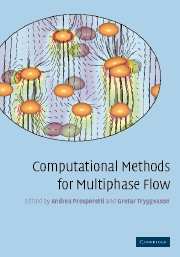Book contents
- Frontmatter
- Contents
- Preface
- Acknowledgments
- 1 Introduction: A computational approach to multiphase flow
- 2 Direct numerical simulations of finite Reynolds number flows
- 3 Immersed boundary methods for fluid interfaces
- 4 Structured grid methods for solid particles
- 5 Finite element methods for particulate flows
- 6 Lattice Boltzmann models for multiphase flows
- 7 Boundary integral methods for Stokes flows
- 8 Averaged equations for multiphase flow
- 9 Point-particle methods for disperse flows
- 10 Segregated methods for two-fluid models
- 11 Coupled methods for multifluid models
- References
- Index
5 - Finite element methods for particulate flows
Published online by Cambridge University Press: 07 December 2009
- Frontmatter
- Contents
- Preface
- Acknowledgments
- 1 Introduction: A computational approach to multiphase flow
- 2 Direct numerical simulations of finite Reynolds number flows
- 3 Immersed boundary methods for fluid interfaces
- 4 Structured grid methods for solid particles
- 5 Finite element methods for particulate flows
- 6 Lattice Boltzmann models for multiphase flows
- 7 Boundary integral methods for Stokes flows
- 8 Averaged equations for multiphase flow
- 9 Point-particle methods for disperse flows
- 10 Segregated methods for two-fluid models
- 11 Coupled methods for multifluid models
- References
- Index
Summary
In Chapter 4 we described finite difference methods for the direct numerical simulations of fluid–solid systems in which the local flow field around moving particles is resolved numerically without modeling. Here we describe methods of the finite element type for the same purpose.
The first method is termed the ALE (arbitrary Lagrangian-Eulerian) particle mover. The ALE particle mover uses a technique based on a combined formulation of the fluid and particle momentum equations, together with an arbitrary Lagrangian–Eulerian moving unstructured finite element mesh technique to deal with the movement of the particles. It was first developed by Hu et al. (1992, 1996, 2001). The method has been used to solve particle motions in both Newtonian and viscoelastic fluids in two- and three-dimensional flow geometries. It also handles particles of different sizes, shapes, and materials.
The second method is based on a stabilized space-time finite element technique to solve problems involving moving boundaries and interfaces. In this method, the temporal coordinate is also discretized using finite elements. The deformation of the spatial domain with time is reflected simply in the deformation of the mesh in the temporal coordinate. Using this technique, Johnson and Tezduyar (1999) were able to simulate the sedimentation of 1000 spheres in a Newtonian fluid at a Reynolds number of 10.
The third numerical method is termed the DLM (distributed Lagrange multiplier) particle mover. The basic idea of the DLM particle mover is to extend the problem from a time-dependent geometrically complex domain to a stationary fictitious domain, which is larger but simpler.
- Type
- Chapter
- Information
- Computational Methods for Multiphase Flow , pp. 113 - 156Publisher: Cambridge University PressPrint publication year: 2007
- 1
- Cited by

